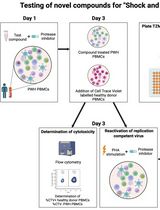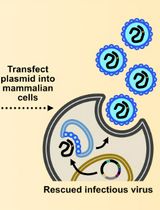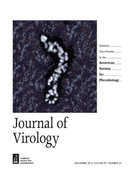- Submit a Protocol
- Receive Our Alerts
- Log in
- /
- Sign up
- My Bio Page
- Edit My Profile
- Change Password
- Log Out
- EN
- EN - English
- CN - 中文
- Protocols
- Articles and Issues
- For Authors
- About
- Become a Reviewer
- EN - English
- CN - 中文
- Home
- Protocols
- Articles and Issues
- For Authors
- About
- Become a Reviewer
In vitro EBV Infection of Mononuclear Cells that Have Been Cryo-preserved
Published: Vol 4, Iss 14, Jul 20, 2014 DOI: 10.21769/BioProtoc.1177 Views: 7896
Reviewed by: Anonymous reviewer(s)

Protocol Collections
Comprehensive collections of detailed, peer-reviewed protocols focusing on specific topics
Related protocols

General Maintenance and Reactivation of iSLK Cell Lines
Ariana C. Calderón-Zavala [...] Ekaterina E. Heldwein
Jun 5, 2025 1517 Views

Inducible HIV-1 Reservoir Reduction Assay (HIVRRA), a Fast and Sensitive Assay to Test Cytotoxicity and Potency of Cure Strategies to Reduce the Replication-Competent HIV-1 Reservoir in Ex Vivo PBMCs
Jade Jansen [...] Neeltje A. Kootstra
Jul 20, 2025 2015 Views

Assembly and Mutagenesis of Human Coronavirus OC43 Genomes in Yeast via Transformation-Associated Recombination
Brett A. Duguay and Craig McCormick
Aug 20, 2025 2204 Views
Abstract
Epstein-Barr Virus (EBV) is a B-lymphotropic herpesvirus which the majority of adult human population is latently-infected with. Various immunological and molecular in vitro studies have been facilitated by the use of EBV’s ability to infect and transform B cells to immortalized polyclonal B cell lines. Many of these studies use freshly isolated cord-blood mononuclear cells (CBMC). Some experiments may, however, require EBV infection of samples that have been prospectively collected and cryo-preserved. Here we share a protocol that we used to successfully infect B cells from cryo-preserved CBMCs and peripheral-blood mononuclear cells (PBMC) (Sohlberg et al., 2013; Saghafian-Hedengren et al., 2013).
Materials and Reagents
- Cryo-preserved CBMC
- Cryo-preserved PBMC
- EBV strain B95-8 containing supernatant
Note: The batch here had a titer of 2.5 x 105 Ramos infectious units. RaIU, which was determined by infection of the EBV negative Burkitts lymphoma B-cell line Ramos, followed by anti-complement immunoflourescent assay (ACIF) to detect the number of infected cells.
- RPMI 1640 (Life Technologies)
- 10% heat-inactivated fetal-calf serum (Hyclone)
- L-glutamine (2 mmol/l)
- Penicillin G-sodium (100 U/ml)
- Streptomycin sulfate (100 mg/ml) (Merck KGaA)
- Complete cell-culture medium (see Recipes)
Equipment
- 48-well flat-bottomed tissue-culture treated plates (Sarstedt AG)
- Humified incubator with for adjustment of 37 °C and 5% CO2 for cell culture
Procedure
Note about sample handling: Gentle and fast processing of samples during isolation of mononuclear cells contributes to higher B cell viability, which is central for successful in vitro infection.
- Thaw CBMCs or PBMCs quickly at room temperature and wash two times with incomplete RPMI-1640 at 350-400 x g and 5-10 min at room temperature.
- Determine cell numbers, and if applicable, divide cells to fractions that will be EBV infected and those that will serve as non-infected controls.
Note: Remember that the cell numbers and concentrations in each well should be matched for the infected and non-infected fractions.
- Wash an additional time with RPMI 1640.
- For non-infected control cultures: Re-suspend cells in complete cell-culture medium to a concentration of 106 cells/ml and allocate to the appropriate wells in the plate. Incubate at 37 °C and 5% CO2.
- For EBV infection, discard supernatant completely and resuspend 106 cells per 100 μl B95-8 virus–containing supernatant in a small tube. Incubate at 37 °C and 5% CO2 for 90 min with gentle mixing by swirling the tube every 30 min.
- Wash the cells once with complete cell-culture medium, discard supernatant and re-suspended in complete cell-culture medium to a concentration of 106 cells/ml and then allocate to the appropriate wells in the plate.
- Feed cells with complete medium on a weekly basis. The proportion of EBV-transformed B cells will increase with time and eventually these cells take over the entire culture. As we assessed the dynamics of NK and T cell and their functional capacity (Sohlberg et al., 2013; Saghafian-Hedengren et al., 2013) in our previous experimental settings, we found a 1-2 week-period of time suitable for this purpose.
- The presence of EBV-infected cells can be confirmed by immunofluorescence staining for latent membrane protein-1 and EBV nuclear Ag 2 (Rasul et al., 2012).
Representative data
Refer to Figure 1 in Sohlberg et al. (2013) for representative data on B cell characteristics following in vitro EBV infection of B cells.
Notes
- Careful and fast processing of samples during isolation of mononuclear cells contributes to higher B cell viability, which is central for successful downstream in vitro EBV infection.
- This protocol uses cells from EBV seronegative donors. Deplete T cells (by for instance magnetic-based methods to remove CD3+ cells from StemCellTM or Miltenyi Biotech) prior to EBV in vitro infection in case samples are from EBV seropositive donors.
Recipes
- Complete cell-culture medium
10% heat-inactivated fetal-calf serum
L-glutamine (2 mmol/l)
Penicillin G-sodium (100 U/ml)
Streptomycin sulfate (100 mg/ml)
Acknowledgments
This protocol has been adapted from the previously published paper Sohlberg et al., (2013). At the time of development and implementation of this protocol, the following sources of funding were used: Swedish Research Council Grants 57X-15160-07-03 and 57X-15160-10-4, the Swedish Association for Allergology, the Ragnar Söderberg Foundation, the Ellen, Walter and Lennart Hesselman Foundation, the Konsul Th. C. Bergh Foundation, the Golden Jubilee Memorial Foundation, the Petrus and Augusta Hedlund Foundation, the Crown Princess Lovisa’s/Axel Tielman’s Foundation, the Swedish Cancer Society, and the Karolinska Institute. E.R. and N.N. are recipients of cancer research fellowships from the Cancer Research Institute (New York)/Concern Foundation (Los Angeles). We thank Ehsan Rasul and Eva Klein (Department of Microbiology, Tumor and Cell Biology, KI, Stockholm, Sweden) for their contribution in optimizing the protocol.
References
- Rasul, A. E., Nagy, N., Sohlberg, E., Adori, M., Claesson, H. E., Klein, G. and Klein, E. (2012). Simultaneous detection of the two main proliferation driving EBV encoded proteins, EBNA-2 and LMP-1 in single B cells. J Immunol Methods 385(1-2): 60-70.
- Saghafian-Hedengren, S., Sohlberg, E., Theorell, J., Carvalho-Queiroz, C., Nagy, N., Persson, J. O., Nilsson, C., Bryceson, Y. T. and Sverremark-Ekström, E. (2013). Epstein-barr virus coinfection in children boosts cytomegalovirus-induced differentiation of natural killer cells. J Virol 87(24): 13446-13455.
- Sohlberg, E., Saghafian-Hedengren, S., Rasul, E., Marchini, G., Nilsson, C., Klein, E., Nagy, N., Sverremark-Ekström, E. (2013). Cytomegalovirus-seropositive children show inhibition of in vitro EBV infection that is associated with CD8+CD57+ T cell enrichment and IFN-γ. J Immunol 191(11): 5669-5676.
Article Information
Copyright
© 2014 The Authors; exclusive licensee Bio-protocol LLC.
How to cite
Saghafian-Hedengren, S., Sohlberg, E., Theorell, J., Carvalho-Queiroz, C., Nagy, N., Persson, J., Nilsson, C., Bryceson, Y. T. and Sverremark-Ekström, E. (2014). In vitro EBV Infection of Mononuclear Cells that Have Been Cryo-preserved. Bio-protocol 4(14): e1177. DOI: 10.21769/BioProtoc.1177.
Category
Microbiology > Microbe-host interactions > Virus
Microbiology > Microbial cell biology > Cell isolation and culture
Do you have any questions about this protocol?
Post your question to gather feedback from the community. We will also invite the authors of this article to respond.
Tips for asking effective questions
+ Description
Write a detailed description. Include all information that will help others answer your question including experimental processes, conditions, and relevant images.
Share
Bluesky
X
Copy link









